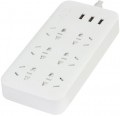Operation indicator
The presence in the design of the surge protector of a special indicator (usually in the form of a light bulb) that indicates that the device is turned on.
This function provides the presence of at least one common indicator; and on models with switches per outlet (see below), additional indicators can be installed on the outlets. Anyway, such equipment makes working with the surge protector more visual, allowing you to immediately assess the status of the device and avoid some unpleasant situations (for example, imaginary equipment breakdowns — when a “faulty” device does not work just because the filter is not turned on).
The indicator can be installed directly in the switch (general or for each outlet, see the relevant paragraphs for details).
Power switch
—
Switch on the body. This function allows you to turn off the power to the load without disconnecting the filter itself from the mains — in other words, it eliminates the need to once again remove the filter plug from the outlet and insert it back. Most often, the switch controls all filter outlets, however, there are models where some of the connectors are bypassed and are always energized, regardless of the position of the switch.
—
A switch for each outlet. This feature makes it easier to manage the power of connected devices: unplugging and plugging individual outlets is usually easier and faster than unplugging and plugging back in. Thus, electrical appliances used with such a filter can be kept constantly connected to it, turning off and on individual outlets as needed.
— Switch for each circuit. The function is used in models with numerous outlets. Allows you to simultaneously disable half of them, leaving the rest working. It combines the convenience of the points listed above and at the same time does not clutter up the device with unnecessary switches.
It is also worth noting that there are models that combine both a switch on the case and a switch for each outlet.
International plug
The number of
universal sockets in the filter, compatible with several types of plugs at once.
Most often, such sockets are made compatible with three types of plugs: a standard “Euro plug” used in Europe and the post-Soviet space, an American Type A plug (two parallel flat contacts) and a Type I plug used in China and Australia (three flat contacts at an angle ). The filter for international plugs is useful for those cases when the household has equipment with different types of plugs — it will allow you to do without additional adapters.
Outlets location
Options for placing sockets on the body of an extension cord or surge protector.
-
Along the hull. Devices with the layout of sockets in one slender line, which is extended along the entire body of the extension cord or surge protector.
-
In 2 rows. A popular scheme with the arrangement of sockets in 2 rows is on both sides of the upper plane of the device housing.
-
In a circle. This category includes all extension cords and surge protectors with sockets in the form of a full circle or a semicircle.
-
On both sides of the body. Sockets on several side faces of the case are found in compact cube models and in advanced surge protectors with relocated sockets on both sides of the case, which makes it easy to connect a large number of consumer devices.

